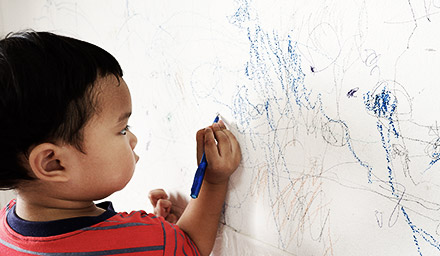As every parent and early childhood educator knows, kids aren’t born well-behaved! They need supportive, understanding adult guidance and teaching to help them learn to model good behaviour and avoid bad behaviour.
Childhood behaviour management means teaching the children in your care the values and habits they’ll need to work effectively in a classroom and get along with others to achieve their goals as they grow.
When this is done effectively, it can be one of the most rewarding aspects of your career as a kaiako. Understanding and being able to guide a child's behaviour with specific strategies is one of the best tools you have as a kaiako to make your classroom an effective learning environment. Good behaviour reduces disruptions and helps tamariki stay in line with you and each other, so everyone is ready for the day's activities.
Positive behaviour as a developmental outcome
Learning positive behaviour is one of the key developmental outcomes that tamariki can achieve at your childcare centre or homebased service. When each child has nurturing guidance, they learn how to behave and be poised for success in kindergarten and beyond into adulthood.
Finally, ensuring good behaviour is an important part of maintaining the safety and reputation of your childcare business. Behavioural issues in kids can become safety issues or lead to conflict if left unchecked. Managing childhood behaviour and collaborating with parents is the best way to prevent these problems.

Set clear expectations for behaviour - (specific, observable, measurable)
When our tamariki know exactly what good behaviour means, it’s easy to follow the rules. Unclear expectations can lead to uncertainty and anxiety — after all, children will rightly feel it’s unfair to be disciplined for not following a rule that wasn't made clear to them.
Remember that kids are still learning what good behaviour means, so they need lots of specifics: “be kind to others” might be too abstract for toddlers, but “let everyone take turns” refers to a real action they can take, and which you can measure objectively.
While providing specific instructions, you don't want to overload kids with too many rules or instructions because they can't remember them all. Strike an age-appropriate balance between describing what you want in general terms ("Put that away.”) and specificity ("Put that back in the cabinet.”) and help kids along by giving them concrete examples and visual aids.
Activity – Age-appropriate rules poster
- For this activity, choose either toddlers or young children.
- Come up with six age-appropriate rules for them.
- Create a poster that could be displayed in an ECE centre or homebased service to help guide children's behaviour.
- Use pictures and colour to create a visual guide to the rules. Remember the tamariki won't be able to read the words.
- Create a journal and upload a photo of your poster.
- Publish it to 'All course users.'
- Find one of your classmates' posters and share your feedback about it.
Create a structured environment with routines and schedules
Routines and schedules give tamariki a sense of security in their environment, leading to confidence, happiness, and good behaviour. Uncertainty about what will happen or what to do can cause anxiety, which usually produces bad behaviour or leaves an opening for children to get distracted and create disruptions.
A visual schedule, reinforced daily, helps kids learn what they’ll need to do next so that they don’t lose focus during transition times. Routines help guide kids through their daily actions in memorable ways that get them excited to do what’s asked of them, whether it’s eating lunch or putting away toys.
Children gain confidence when their expectations are met. ("I thought we were having snack time next! I was right! Yes!")
Activity – create a schedule
- Choose to do this activity for toddlers or young children.
- Map out what you think an ideal day in a learning centre might look like for your chosen age group.
- Create a poster-sized visual schedule that you could display in an ECE centre or homebased service that maps out a typical day's activities for your chosen age range.
- Take a photo or screenshot and create a journal post. Be sure to Publish it to 'All course users.'
Consider situational and environmental factors
Good behaviour doesn’t happen in a vacuum. When you set kids up for success with your classroom management skills, you’ll find that half the job of classroom discipline is already done. A well-organised, harmonious classroom environment reduces stress on kids, and encourages them to maintain that sense of well-being.
For instance, an age-appropriate organisational system makes it much easier for kids to put away toys. Consider how your schedule supports kids, so it's easier for them to do their best. For example, don't plan quiet activities like Storytime right before a meal, when kids are naturally getting antsy.
Activity – review and analyse a schedule
- Look at your classmates' journal postings for the daily schedule they created in the last activity. You may need to wait until some have been posted if you are further ahead than your classmates.
- Compare it to our suggestion that the schedule needs to consider situational and environmental factors that can support tamariki to do their best to follow and behave positively.
- Using respectful language (always), place feedback on your classmates journals about what they did well, and if there is anything about it that you think could have been improved.
Encourage good behaviour with praise and positive attention

Tamariki need to know that doing their best will be rewarded. Positive feedback makes them feel valued and shows them that good behaviour benefits them too. Positive feedback helps kids identify good behaviour for themselves, especially when they see others receiving praise.
Be on the lookout for kids who are cooperating, helping, taking initiative, and working to improve their behaviour. Be ready with a smile or a "good job." Best of all, try to offer specific praise that acknowledges the child's efforts — this makes kids eager to please you again. For example, try "Tane, you listened very well and put away the blocks quickly today!" instead of "Tane, good job."
Create a reward menu for good behaviour
A reward chart or reward menu is a great visual way to reinforce the idea that good behaviour in the classroom matters and is valued. By letting kids visually see how their actions lead to rewards, you help them get excited to do their best, as well as build the important developmental skill of learning to make progress toward a goal over time.
Activity – create a reward chart — but not in English
You may have children from various backgrounds in your care. Being able to say a few words in their language will also boost their confidence and give them a sense of belonging.
- Create a reward chart or reward menu in a language other than English that could be displayed in an ECE centre or homebased service.
- Use pictures and common positive phrases from your chosen language on your chart.

Stay in control with rational detachment
As the adult in the classroom, it’s up to you to make sure that you maintain control by not getting angry, defensive, or otherwise emotional when bad behaviour happens. Giving in to these emotions creates shame, blame and guilt, which can cause children to withdraw or continue their bad behaviour.
Instead, focus on maintaining understanding and compassion while still reinforcing age-appropriate consequences. Your guidance and good faith will help kids stay confident that they are validated and supported, which leads to better outcomes in the long run.
Observe and document bad behaviour to understand the cause
To know how to address behavioural issues in children best, it’s a good idea to record it when it happens. Whether unexpected behaviour is a one-off or happens over and over, taking the time to document it while your memories are still fresh will help you understand why it happened and the appropriate next steps.
When you are documenting behaviour, remember that others may read your notes at some point, so try and leave your feelings, or assumptions out of it. For example, don't write "Natalie is not smart at all, and gets frustrated when she doesn't understand how to use a new toy." The sentence reads much better when you don't comment on Natalie's intelligence and just state what you saw. Police, parents, and others may ask to see the notes in a worse-case situation.
What to document
- Consider what was happening just before the poor behaviour.
- Could it have been prevented?
- Did your reaction make the situation worse or better?
- What would you do differently next time?
Childcare management software provides tools to make behaviour reports and track children's progress over time. This enables you to identify patterns and make sure you're meeting each child's individual needs.
Activity - documenting poor behaviour
Think about the following questions and put your thoughts in a journal post.
- Decide how you will document this information.
- Will you use software, create a document, use a spreadsheet, or write it into a dedicated notebook?
- Who needs to see it, and who shouldn’t see it?
- What are the things you will document about the behaviour?
- Who can you reach out to about the behaviour if it becomes a problem that happens over and over?
Discourage mild misbehaviour with active ignoring
For kids, attention is a reward in its own right. Often, kids will act out in mild ways out of boredom or the desire to be noticed. For this type of misbehaviour, drawing attention to it can reinforce the action and create further disruptions.
Activity - planned ignoring
Use the arrows to progress through these five cards and learn more about ignoring inappropriate behaviour.
Actively ignoring (rational detachment) mild misbehaviour, coupled with consistent reinforcement of positive behaviour, teaches kids that if they want your eyes on them, they’ll have to earn it by trying their best. After ignoring them, be sure to complete the lesson: keep your eye out for the next time you can positively affirm good behaviour in the same child.
Establish and enforce effective consequences
While positive reinforcement is the primary way to ensure kids live up to your classroom expectations, setting consequences is necessary to prevent bad behaviour. Kids will understand and respect your rules when consequences are known in advance, consistently applied and proportional.
Setting consequences helps kids progress toward the behaviour you want to see. To foster that growth, consequences should have a clear connection to the behaviour involved — for instance, if a child is misusing a toy, a natural consequence would be that he cannot use that toy for the rest of the day.
Activity – natural and logical consequences
Consider what are some effective consequences that you could establish for misbehaviour in your ECE centre or Homebased service?
To complete this activity:
- Download this document and open it in MS Word or Google Docs.
- Complete the column on the right, adding consequences for example behaviours.
- Add two rows with behaviours and consequences.
- Upload a screenshot to a journal post.
- Reflect on this activity.
- Add comments in your journal about what it felt like to think about bad behaviour and how you will manage it.
Collaborate with Parents

A child's experience at home can have a large impact on the child's behaviour in a daycare setting.
Parents are vital partners in guiding kids toward being on their best behaviour — after all, it’s a goal they share, too! Take advantage of the valuable insights parents can offer from their extended one-on-one time with their kids — they can help you learn how best to respond to behaviour in your classroom.
By working together, you can ensure that your approach to discipline is consistent and effective. It’s also a great way to build trust and nurture relationships with families, by showing them that you’re their partner in helping their child reach full potential.
Activity suggestions
These suggestions will help guide children's behaviour at different ages.
| Eighteen-Month-Old | |
|---|---|
|
|
| Two-Year-Old | |
|
|
| Three-Year-Old | |
|
|
| Four-Year-Old | |
|
|

